Valour and Fortitude : a new set Napoleonic rules
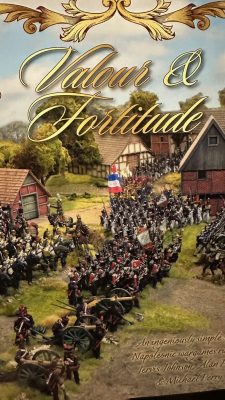
By Tom Gall
Contained within the new September 2022 issues of Wargames Illustrated is a set of Napoleonic Rules call Valour and Fortitude. Jervis Johnson, Allen Perry and Michael Perry are the authors. The Perrys of course are from Perry Miniatures fame and Jervis Johnson a long-time and recently retired distinguished veteran from Games Workshop.
The rules started out as a 4-page system that expanded a bit after play testing over time. The rules are available online at Perry Miniatures as well as army lists and scenarios. The rules appear to be a living document and have already been updated to version 1.2 since their initial posting a couple of months back. (Edit – And now version 3 has been posted!)
I’m a long-time gamer of the Napoleonic era as well as a re-enactor. (French Fifer) It’s great to see activity for this time period of miniatures gaming. Locally our game group has primarily used Empire for large battles and either home brew for skirmish or Sharp Practice. ESR also deserves mention as it has recently attracted attention with its version 3 release and great campaign books.
No matter the ruleset the one thing that tends to crinkle an eyebrow when it comes to new Napoleonic rule systems is basing. Often when moving from one system to another, either a rebase is required or sometimes even new scales are proposed. Valour and Fortitude doesn’t try and force you into a scale or basing, it just wants your forces to be consistent on the table. While the rules are written for 28mm, it scales fine to 15mm which for the play-through we did worked quite well.
Valour and Fortitude basic units are battalions of infantry, artillery guns and squadrons of cavalry. The army lists suggest 24-36 figures for a French battalion. For our 15mm game we 1/2ed and that worked fine. More figures on the tabletop are certainly pretty OTOH work with what you have, you’ll do fine with this system.
Core Mechanics
The rules are contained within 4 pages. Very tight and well-crafted. If you’re an experienced Napoleonic historian/gamer you’ll probably ask yourself various “what about…” types of questions as you explore the rules. Indeed in a work of this size, it can’t capture every nuance of the period. It aims to provide a succinct set of rules that enables you to play an entertaining game within a reasonable amount of time.
A turn is divided up into four phases. One side goes through all four phases followed by the other side. The phases are Fate, Fire, Action and Melee.
The Fate Phase: Each side has one suite from a deck of cards. Ace through deuce. This 13-card “deck” is shuffled and each Fate phase a card is drawn. Each army list has its own entries for each of the 13 cards. There is a little difference in these 13 outcomes between the different nationalities but not a lot from what we could tell. A fate card might give you extra action or other general good “things” that you could apply to help your force.
The Fire phase is as it sounds, this is for any unit on your side that is within range of the enemy the opportunity blaze away with musketry fire. Fire is conducted with d6. Depending on the type of infantry, you might be rolling between 2-4 dice. There are few modifiers, and hits start out as a 4+. If more than one regiment/battalion is going to be shooting at the same enemy unit, it is done through a supporting attack mechanism and instead of combining attack dice, a single dice is added per unit joining in the shot. Units all have a Tenacity rating and that dictates how many hits may be absorbed before the unit is shaken. The system has no concept of “saves”, a hit is a hit.
The Action phase starts out by attempting to activate brigades, a d6 is rolled and anything but a 1 will succeed in activating a bridge to perform a section of actions such as reform, rally, march, and charge. Once all the brigades have been attempted to be activated the phase ends. Units which are shaken can cause a brigade to be wavering and that makes activation a 3+ dice roll.
The variety of actions in the Action phase are straight forward. Reforming the formation of your units is straightforward and not burdensome. The usual formations you would expect are in the game such as line of battle, square, attack column, march column and so on. As you’d expect the formation you have your men in matters based on what you are asking them to do.
Last, the Melee phase is for those units that are in contact and duking it out with bayonets, sabres and so on. Cavalry in Melee, as expected, is quite deadly and needs to be respected, form square or your infantry will be cut down.
Morale in the system applies to individual units as well as brigades. Brigades are made up of anywhere between two and eight or so units and generally didn’t mix Infantry and Cavalry. As a unit is taking hits, when the number of hits equal the unit’s tenacity, it becomes shaken. Hits above the tenacity rating cause you to have to take Valour tests. If you fail a Valour test, it’s a pickup. Every time a unit shakes or routes, that counts as a setback to the brigade. If a brigade has three setbacks it is considered wavering. A wavering brigade is harder to activate. Each time a brigade that takes a setback beyond three, must take a Fortitude test, failure and the entire brigade is removed from play.
How does it Play?
The army lists in Valour and Fortitude are point costed. For the first game, I didn’t pay attention to points and put together a reasonably similar Russian and French force set in 1812. We set a somewhat boring table in an effort to get figures on the table and play things out, both sides had three Brigades, where two were composed of about 3 battalions of infantry and an artillery piece. The third brigade was a cavalry formation made up of generally three units, I gave the French better cavalry which the Russians had one unit of dragoons, a unit of cossacks and a light hussar squadron.
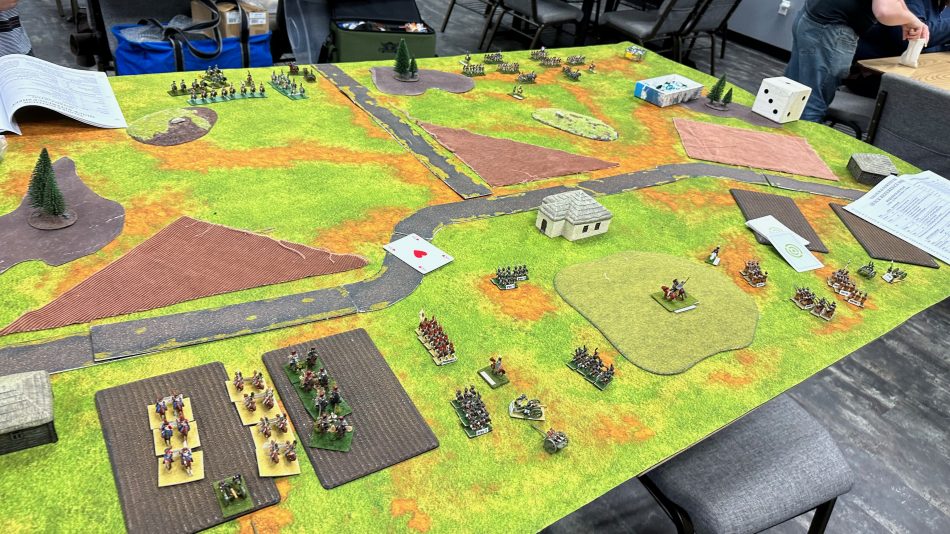
Turn 1 from the Russian side, Cavalry on the left flank, and the two infantry brigades in the middle and left. The hills and crossroads are the objectives. Whoever holds most of them at the end of the game wins.
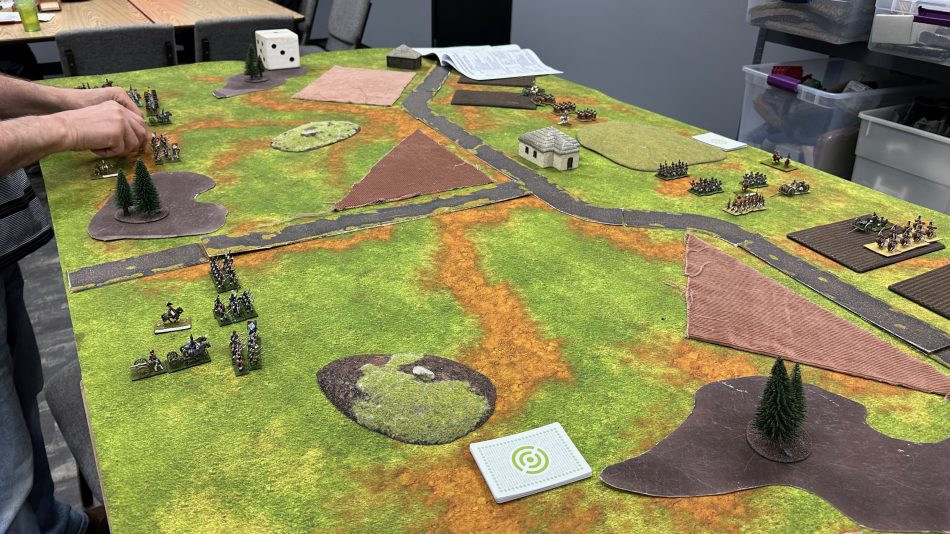
From the vantage point of the French side, they’ve decided to deploy their cavalry on the opposite side of the table and a brigade of infantry and each side of the forest next to the road.
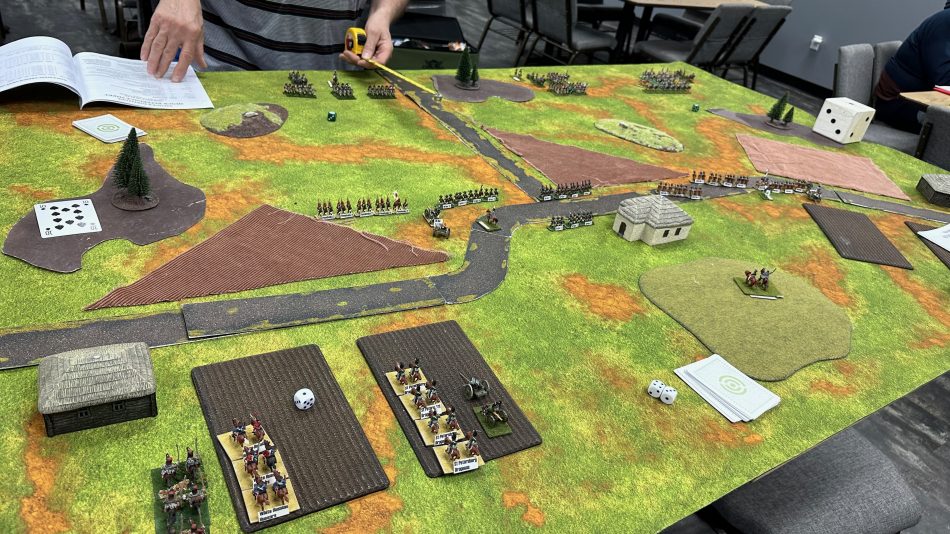
The Russians fail to activate their cavalry on turn 1 but the infantry pushes ahead and takes up a defensive line by the road. This gives them an initial two of the four objectives. Can they hold them? Well if the cavalry might actually decide to help.

The French cavalry on the opposite side of the table decides to dash across to try and get behind the Russian lines. The Russian brigade commander on this side has more than a slight worry.
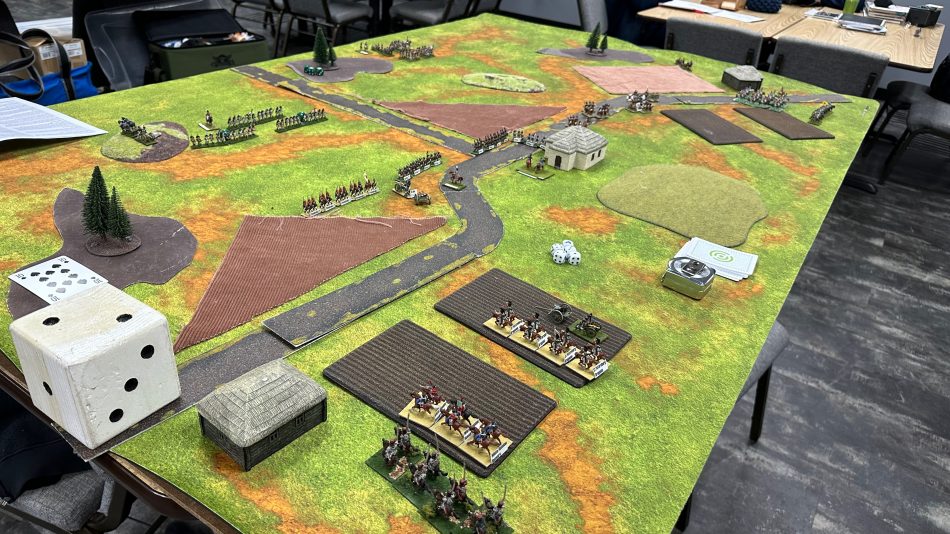
The French moved up in line, and for turn 2, some units are just within 12″ musket range. Canon range of course is much longer. The Russian cavalry again decides it won’t be activating this turn. On the Russian right flank, they do activate and form square.

The French charge one unit hitting the Russian artillery and avoiding the square. It’s possible that square might have been able to join in the scrum but didn’t. We might have played that wrong. Regardless the Russian gun is easily dealt with. As there isn’t a way to consolidate after a charge, or seemingly a concept of disorder after a charge, the French cavalry is where they are. The Russians dare not break square.
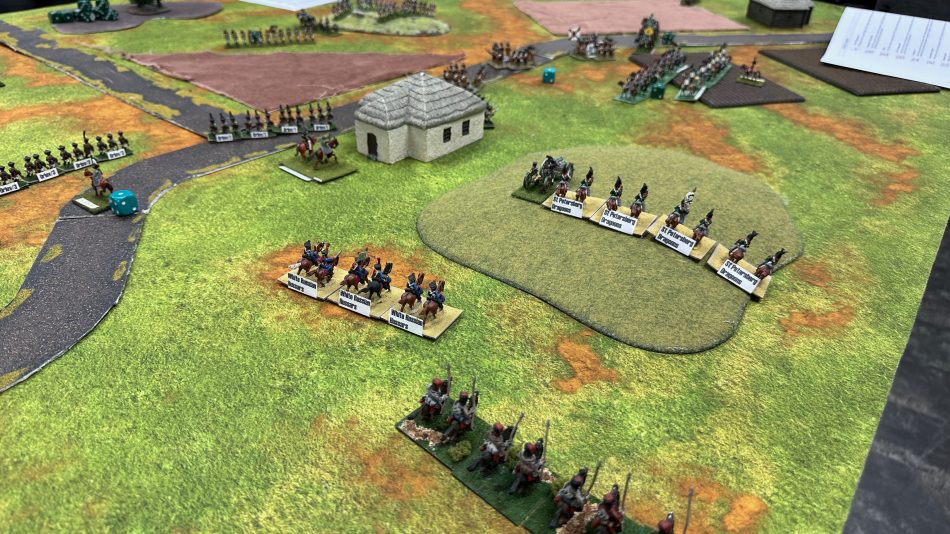
Turn 3 the Russian cavalry decides they’ve had enough coffee or whatever and get moving. Will they rescue the Russian right flank?

Meanwhile, the Russians do fire out of square and land a hit or two. Not very effective fire but it’s something.
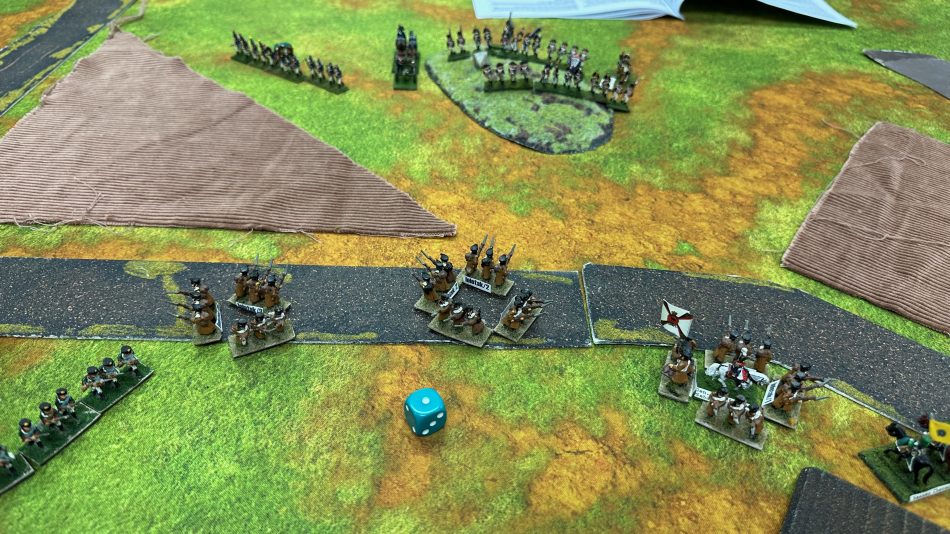
The Russian right flank is entirely in peril as the French infantry has arrived and will be engaged shortly. Note the die with a ‘1’ that is the recording of the setback for that Russian Brigade.

Meanwhile, on the French right flank/Russian left flank, it’s a long-range musketry duel with a little artillery support. The French managed to shake the Russian artillery piece and the Russians did put some hits into two of the French line infantry units. Neither side is really making progress as of yet.
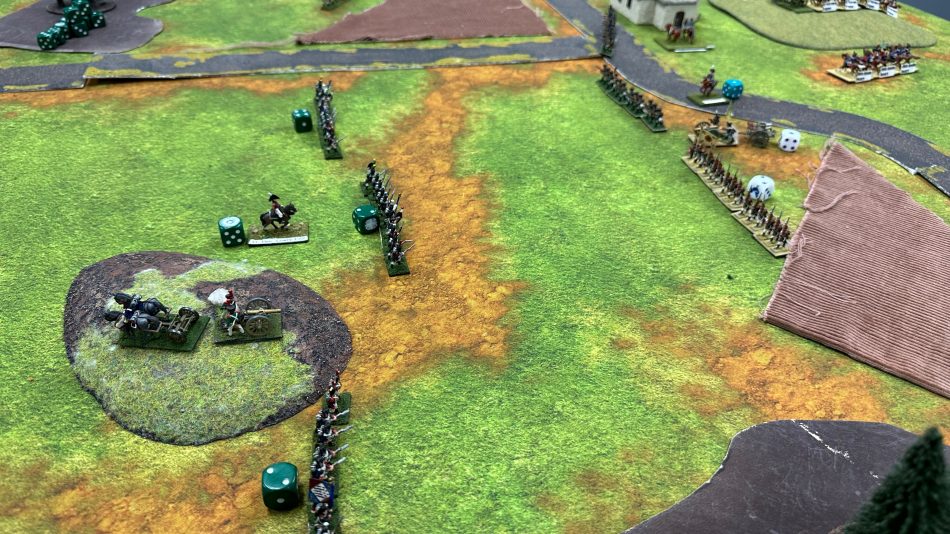
Another vantage point.
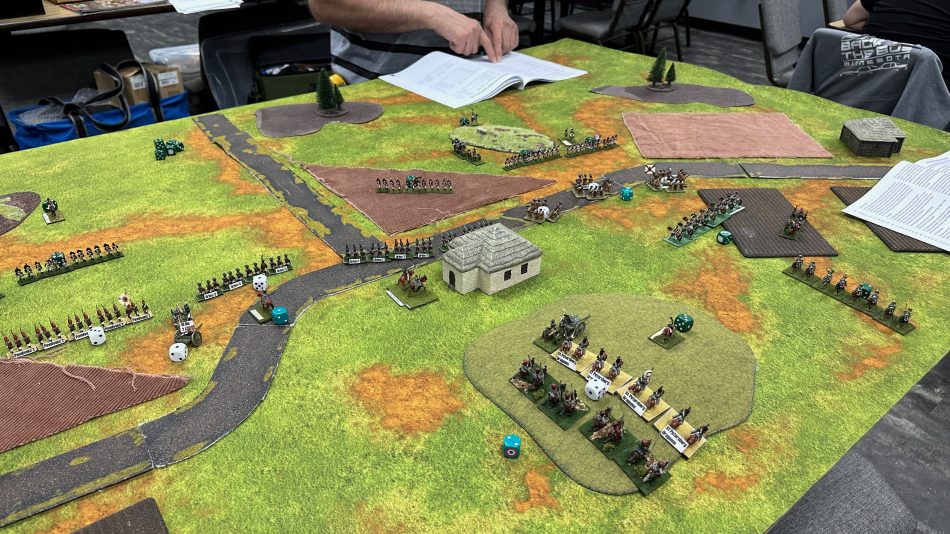
The French and Russian cavalry are staring each other down. The French charge their hussars vs the Russian Dragoons. It’s heavy vs light cavalry with the advantage to the Russians. A rare moment when they win. The French then send their Cuirassiers to setting the matter and while the Dragoons have Cossacks in support, it won’t be quite enough. More on that in a bit…

Turn 4, the casualties are starting to mount and either line could break fairly quickly. As neither side has reserves it’ll be decided soon.
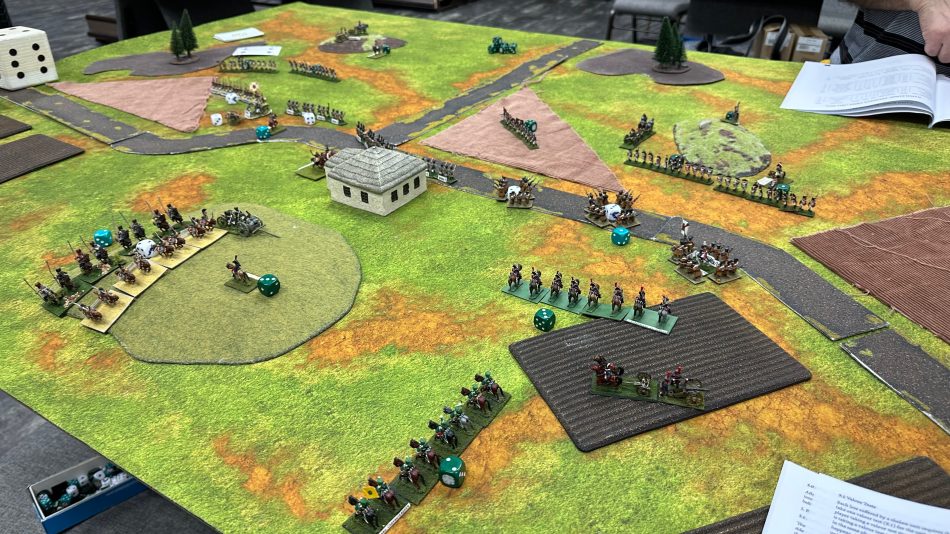
The French fire effectively on the Russians still in square, and with the number of setbacks, the whole brigade evaporates.

The French charge the hill as previously mentioned, they win the melee, destroying the Russian Dragoons. enough damage is put into the French cavalry such that they likewise decide they’ve had enough. At this point at the bottom of turn 5, it’s two French infantry brigades on on Russian infantry brigade that is wavering. The French will win the day.
A good game played in approx 2 1/2 hours with some amount of looking up various rules.
Final thoughts
Fast play games where you can set up, play and get to a result in a reasonable amount of time have their place. The Valour and Fortitude rules offer that kind of experience set in the Napoleonic era. I find the rules playable and generally reasonable. I’ll play them again. I especially want to try out something point costed. There is an interest on my part in wondering if this set of rules can be used in a tournament setting. That could be fun.
I do see some need for improvement and given the nature of a living set of rules, I’m hopeful that there will be future additions. My list of considerations I hope to see addressed:
- Long-range fire seems there should be some sort of modifier
- Leadership especially quality (or lack thereof!) feels like it needs to be added somehow.
As this story was being drafted the stats for Peninsular forces has appeared on the Perry Miniatures website as a free download. Great to see!
